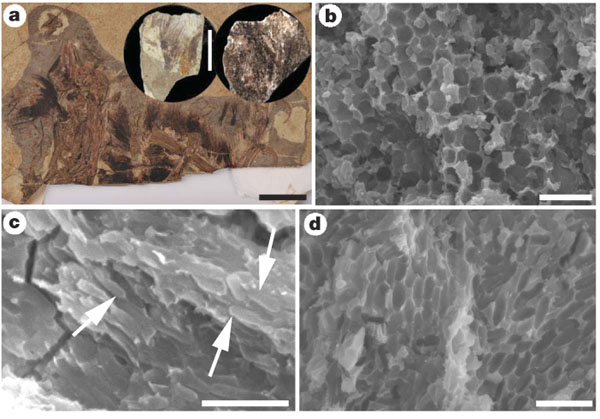Spectacular fossils from the Early Cretaceous Jehol Group of northeastern China have greatly expanded our knowledge of the diversity and palaeobiology of dinosaurs and early birds, and contributed to our understanding of the origin of birds, of flight, and of feathers. Pennaceous (vaned) feathers and integumentary filaments are preserved in birds and non-avian theropod dinosaurs, but little is known of their microstructure.
Dr. Fucheng Zhang, Institute of Vertebrate Paleontology and Paleoanthropology, Chinese Academy of Sciences, and his collaborators, recently report that melanosomes (colour-bearing organelles) are not only preserved in the pennaceous feathers of early birds, but also in an identical manner in integumentary filaments of non-avian dinosaurs, thus refuting recent claims that the filaments are partially decayed dermal collagen fibres. Examples of both eumelanosomes and phaeomelanosomes have been identified, and they are often preserved in life position within the structure of partially degraded feathers and filaments. Furthermore, the data here provide empirical evidence for reconstructing the colours and colour patterning of these extinct birds and theropod dinosaurs: for example, the dark-coloured stripes on the tail of the theropod dinosaur Sinosauropteryx can reasonably be inferred to have exhibited chestnut to reddish-brown tones.

Melanosomes in feathers of the bird Confuciusornis (IVPP V13171). a, Optical photograph. b, Strongly aligned, closely spaced, eumelanosomes preserved as solid bodies. c, Mouldic (that is, preserved as moulds) eumelanosomes (at arrow) a short distance above a layer in which the eumelanosomes are preserved as aligned solid bodies. d, Area (at arrow) comprising more widely spaced mouldic phaeomelanosomes surrounded by less distinct, aligned eumelanosomes (top of image). e, Gradational boundary between areas dominated by eumelanosomes (longer arrows) and phaeomelanosomes (shorter arrows), both preserved as solid bodies. Scale bars: a, 50 mm; b–e, 2 mm.
The occurrence of melanosomes in fossil birds and non-avian dinosaurs allows the first opportunity to reconstruct certain aspects of the external coloration of these organisms. The colours, and their hues and shades, of modern bird feathers derive from a variety of pigments, including melanin, as well as the microstructural arrangement of the tissues. The identification of both eumelanosomes and phaeomelanosomes implies that some basal birds and non-avian theropods had black and russet coloration. In Sinornithosaurus the filaments are locally dominated either by eumelanosomes or phaeomelanosomes, indicating significantly different colour tones. In Confuciusornis, variation in colour within a single feather is indicated by changes in the relative abundance of phaeomelanosomes and eumelanosomes over short distances. Only phaeomelanosomes have been identified so far in filaments from the tail of Sinosauropteryx, and this suggests that the dark-coloured stripes along the tail in the fossil, and possibly also the filamentous crest along the back, exhibited chestnut to rufous (reddish-brown) tones. As the melanosomes are preserved in life position in the Jehol fossils, detailed study of differences in their spatial distribution, including orientation and density, and the relative abundance of each type, will reveal greater detail regarding both colour and colour patterning. Reconstruction of colour patterns will also inform debates on the functions of feathers in non-avian dinosaurs, whether primarily for thermoregulation, camouflage or communication.
The original paper was published in Nature 08740. doi:10.1038
